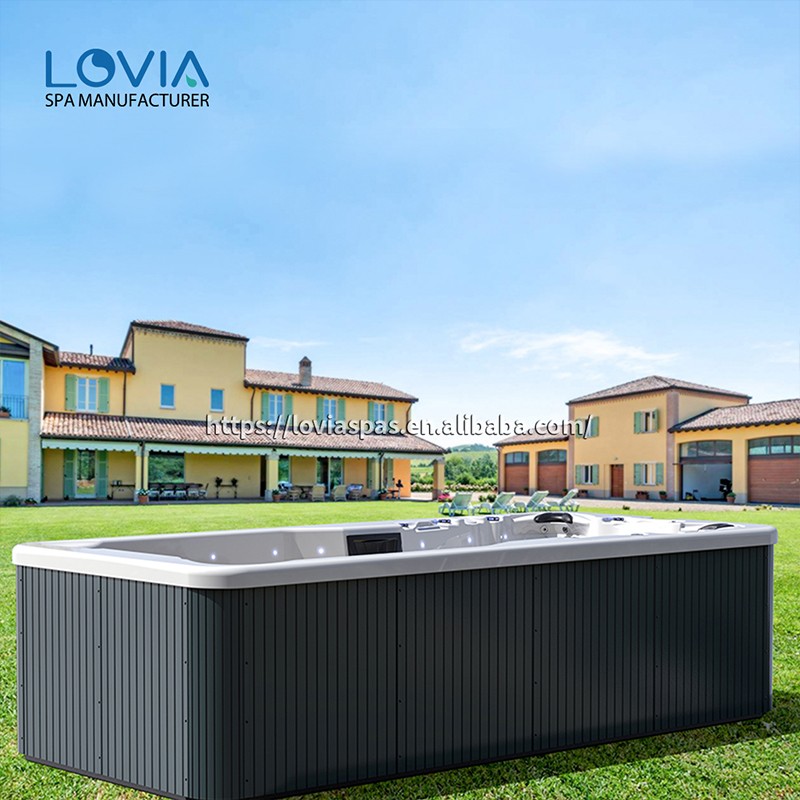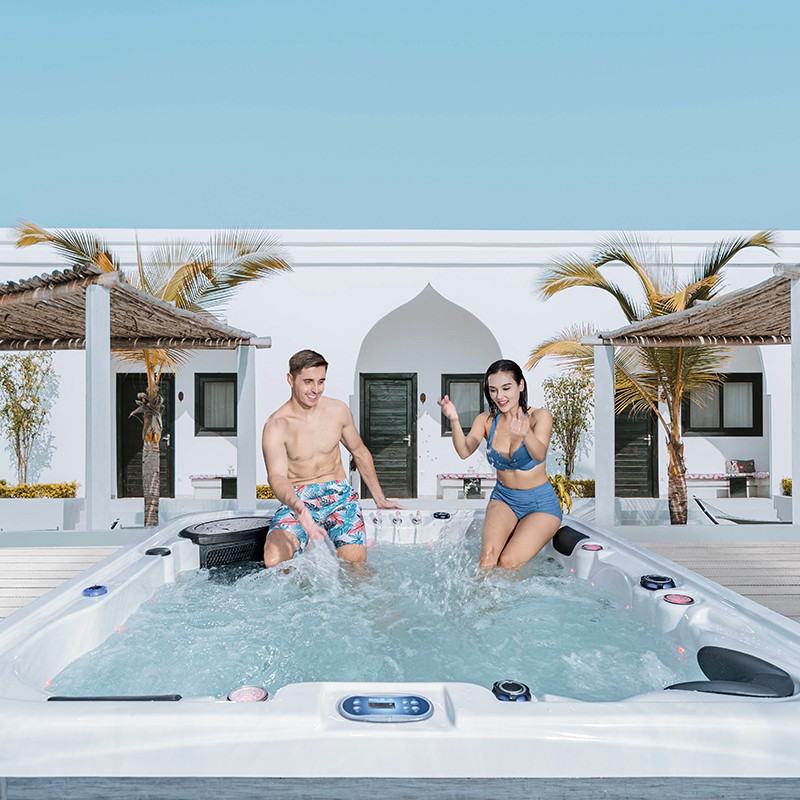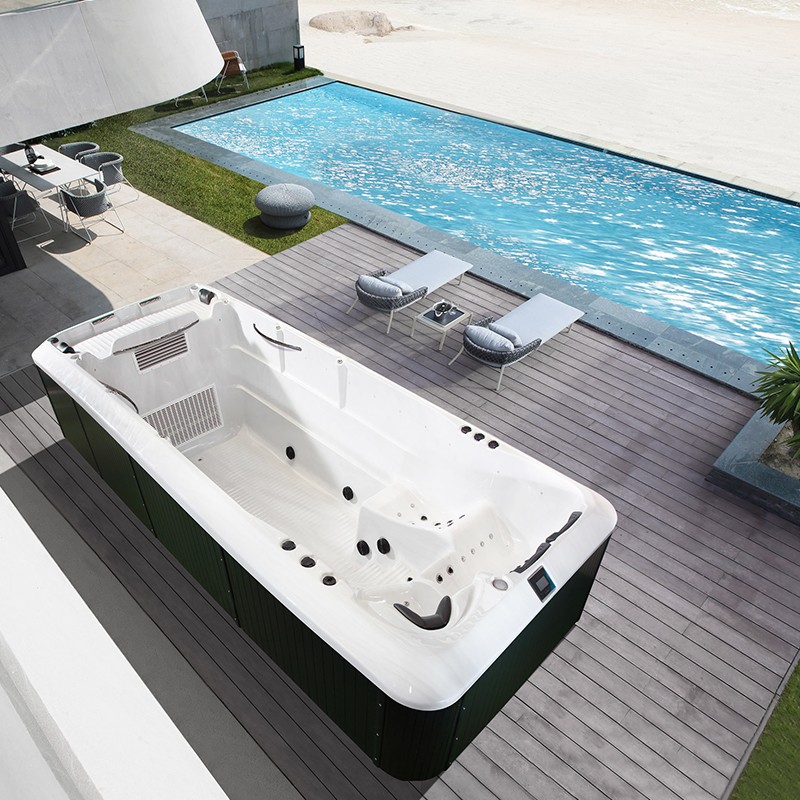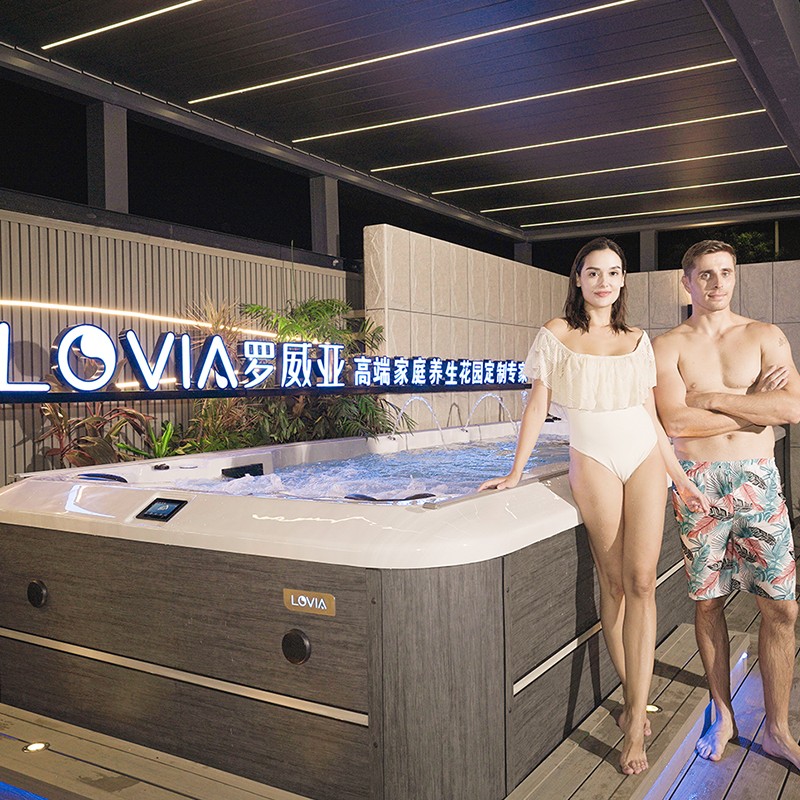
Will the chlorine content in the swim spa tub drop by itself?
2025-07-24 15:35As a facility that integrates rehabilitation, entertainment and fitness functions, swim spa tubs are increasingly appearing in private homes, fitness centers and health care facilities. In order to ensure the cleanliness and safety of water quality, maintainers usually use "chlorine" as the main disinfectant.
In actual use, many people find that the chlorine content in the swim spa tub will gradually decrease even without new users or external pollution sources.
Does this mean that the chlorine content in the swim spa tub will drop by itself? If so, what is the reason? Is it related to the environment, chemical reactions or other substances in the water? Understanding this phenomenon is of great significance for maintaining the stability of bathtub water quality, controlling costs and ensuring safety in use.
This article will systematically analyze the reasons for the change of chlorine content in the swim spa tub from multiple dimensions such as the chemical properties of chlorine, environmental factors of spa baths, changes in water quality dynamics, and user behavior, clarify whether it will drop by itself, and propose targeted management measures.

The role and existence form of chlorine in the swim spa tub
In the swim spa tub, the main functions of chlorine are sterilization, oxidation of impurities and control of algae reproduction. But to understand whether chlorine will decrease "by itself", we must first clarify what form it exists in the water.
1. Free Chlorine
Free chlorine is the main active ingredient, including hypochlorous acid (HOCl) and hypochlorite (OCl⁻) in two forms. This part of chlorine has a strong bactericidal effect and is a key indicator for detecting chlorine concentration in water.
2. Combined Chlorine
Combined Chlorine is chloramine (such as NH₂Cl) formed by the reaction of chlorine and ammonia substances. It has weak bactericidal ability and can also cause a pungent odor in the swim spa tub water.
3. Total Chlorine
Total Chlorine = Free Chlorine + Combined Chlorine. For swim spa tub water quality management, controlling free chlorine is more important than simply maintaining total chlorine.

Will the chlorine content in the swim spa tub decrease by itself?
The answer is yes: the chlorine content in the swim spa tub will indeed decrease by itself without human intervention, and it is a dynamic and complex process.
Next, we scientifically explain the mechanism of its natural decline from multiple aspects.
The mechanism of natural decline of chlorine content:
1. Ultraviolet decomposition
Even if the swim spa tub is indoors, as long as there is light, ultraviolet rays will cause chlorine to decompose.
· Photochemical reaction: Ultraviolet rays can interrupt the molecular structure of HOCl and convert it into ineffective Cl⁻ and O₂.
Especially in outdoor bathtubs, strong sunlight can significantly reduce the chlorine content in the swim spa water, often reducing it by more than 50% in a short period of time.
· Reaction formula: 2HOCl+sunlight→2HCl+O2↑2HOCl + sunlight → 2HCl + O₂↑
2. Rising temperature leads to volatilization and decomposition
Swim spa tubs are usually heated to 35–40°C, which is significantly higher than ordinary swimming pools.
· High temperature accelerates the volatilization of chlorine, especially the release of HOCl.
· It also speeds up the reaction rate of chlorine with other chemicals, causing it to be consumed faster.
Conclusion: The higher the temperature, the shorter the life of chlorine.
3. Reaction and consumption of organic pollutants
Sweat, urea, dandruff, skin care product residues, etc. brought into the swim spa tub by the human body contain a large amount of organic nitrogen, protein and other impurities, which will react with free chlorine for oxidation:
·Chlorine is consumed in the oxidation of these organic impurities.
·Chloramines are formed, increasing the proportion of combined chlorine and reducing the disinfection efficiency.
4. Chlorine and ammonia form combined chlorine
Human body fluids and cosmetics often contain trace amounts of ammonia substances, which react with chlorine to form combined chlorine, thereby reducing the level of free chlorine:
NH3+HOCl→NH2Cl+H2ONH₃ + HOCl → NH₂Cl + H₂O.
This reaction does not depend on sunlight or temperature. As long as ammonia exists in the water, chlorine will continue to be consumed.
5. Reaction of chlorine with metal ions
Some water sources contain metal ions such as iron and copper. These metals will be oxidized by chlorine, causing the chlorine to decompose or transform:
Fe2++HOCl→Fe3++Cl−+OH−Fe^{2+} + HOCl → Fe^{3+} + Cl⁻ + OH⁻ 。
Although this part of the consumption is not large, it will accumulate in long-term use.
6. Natural volatilization of chlorine
Chlorine is unstable in the water of the swim spa tub and easily evaporates in a gaseous state, especially during the process of water agitation and bubble impact:
·The jet system of the swim spa tub enhances the water-air contact and promotes the escape of chlorine.
·High water temperature further increases the rate of this process.

What factors affect the rate of chlorine decline?
The natural decline of chlorine in the swim spa tub is not a linear change. It is affected by the following multiple factors:
1. Water temperature
·The chemical reaction rate almost doubles for every 10°C increase in water temperature;
·The normal temperature of the swim spa tub is much higher than that of the swimming pool, which is more likely to accelerate the loss of chlorine.
2. Water surface exposure area
·Open swim spa tubs or uncovered bathtubs have a larger water surface, and chlorine evaporates faster;
·A covered system can reduce chlorine escape.
3. Cycle frequency and bubble system use
·Bubble generation disturbs the water surface and releases chlorine;
·Using the nozzle system for a long time will increase the evaporation rate of chlorine.
4. Frequency of use
·The more frequent the use, the more human pollutants, and the greater the reaction consumption of chlorine;
·The chlorine decrease in bathtubs with long rest time is mainly due to natural decomposition.
Actual manifestations and problems of chlorine content decrease
When the chlorine content in the swim spa tub continues to decrease, it will cause a series of problems:
·Disinfection failure: bacteria, viruses, and algae reproduction.
·Water quality deterioration: water becomes turbid and has an odor, and the user experience decreases.
·Pipe system pollution: internal mucus accumulates and is difficult to clean.
·Increased maintenance costs: more frequent water changes or "shock treatment" are required.

How to monitor and deal with the natural decline in chlorine content?
In order to cope with the natural loss of chlorine and maintain the quality of swim spa tub water, the following management strategies must be adopted:
1. Regularly test the chlorine content
· Test at least 1-2 times a day;
· Focus on measuring the free chlorine concentration (recommended value is 2-3 ppm);
· Use high-precision titrators or electronic detection instruments.
2. Cover and reduce sunlight exposure
· Choose equipment with sunshade structure or UV protection cover;
· Cover the bathtub after each use to reduce light and evaporation.
3. Reduce unnecessary water disturbance
· Turn off the bubble and injection system when not in use;
· Control the use time to avoid long-term no-load operation.
4. Do a good job of user management before bathing
· Emphasize the shower system before bathing;
· It is forbidden to wear cosmetics and use skin care products when bathing.
5. Regular chlorine supplement or shock treatment
· Replenish chemicals reasonably according to the chlorine decline curve;
· Perform shock treatment once a week or every two weeks to increase the free chlorine level.
Are your spa products energy-efficient?
Yes, our spas are designed with energy-saving features including thick insulation, eco-friendly circulation pumps, and programmable control systems. Many of our models are engineered for cold-weather performance and energy conservation. Buying from our factory ensures that you are providing your customers with high-efficiency spa solutions that meet international energy standards.
